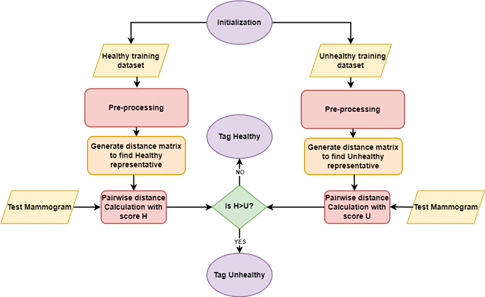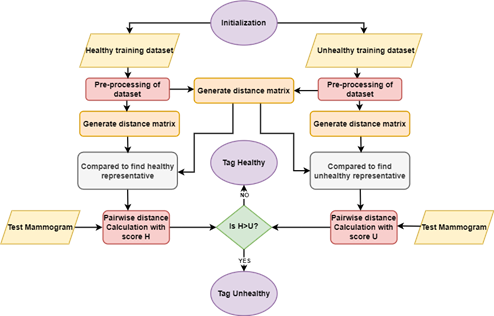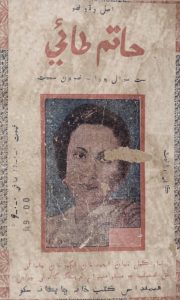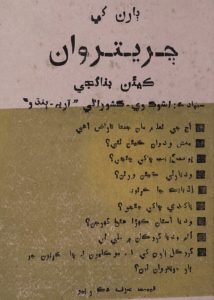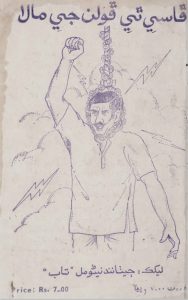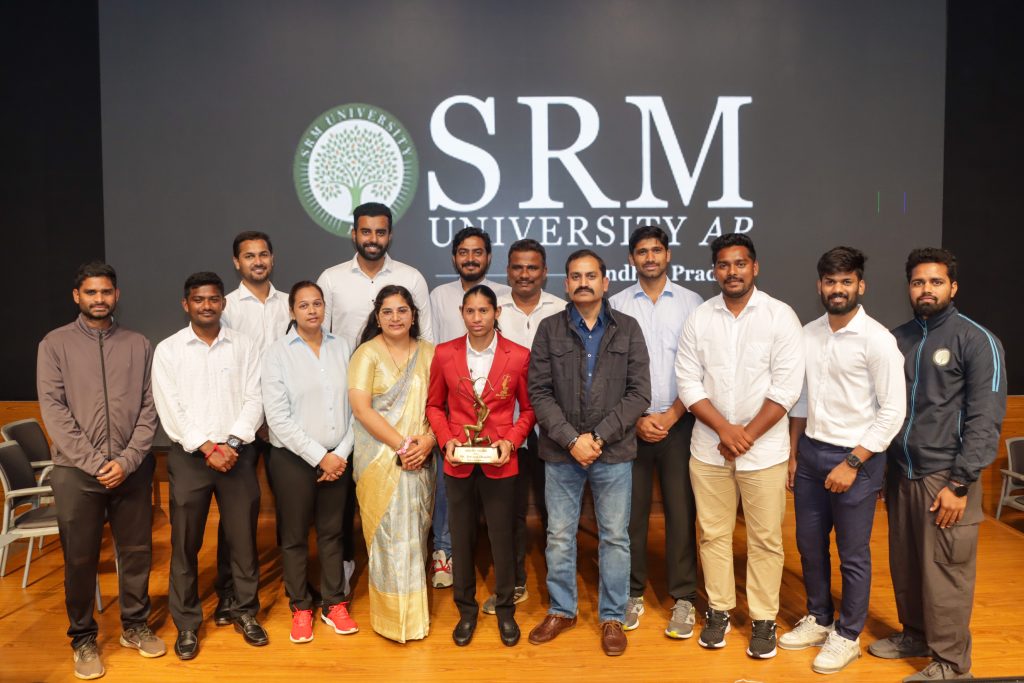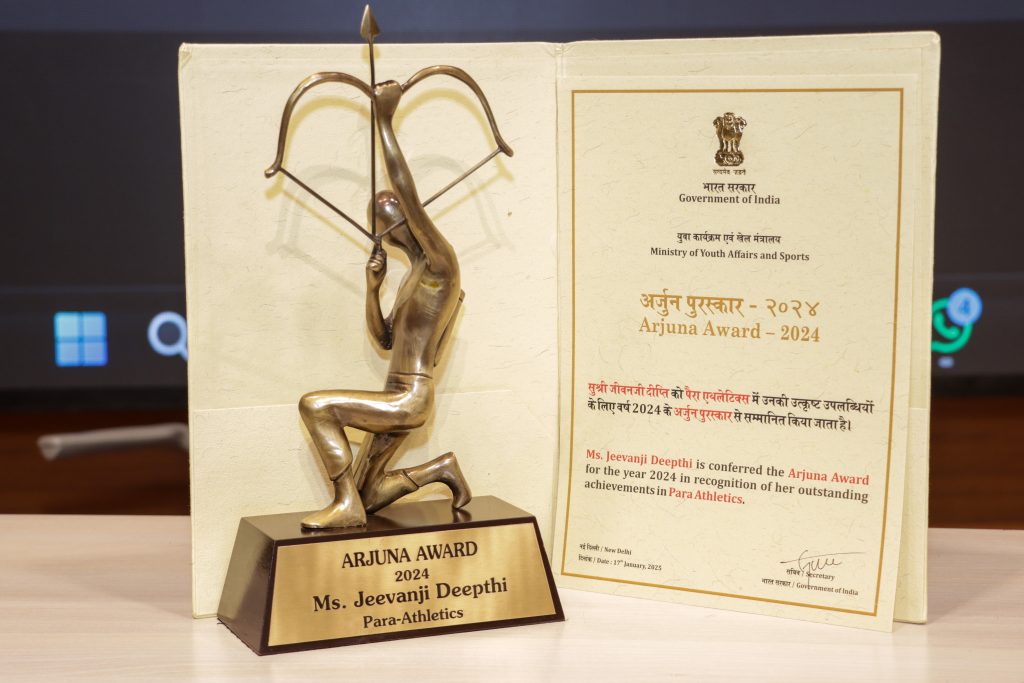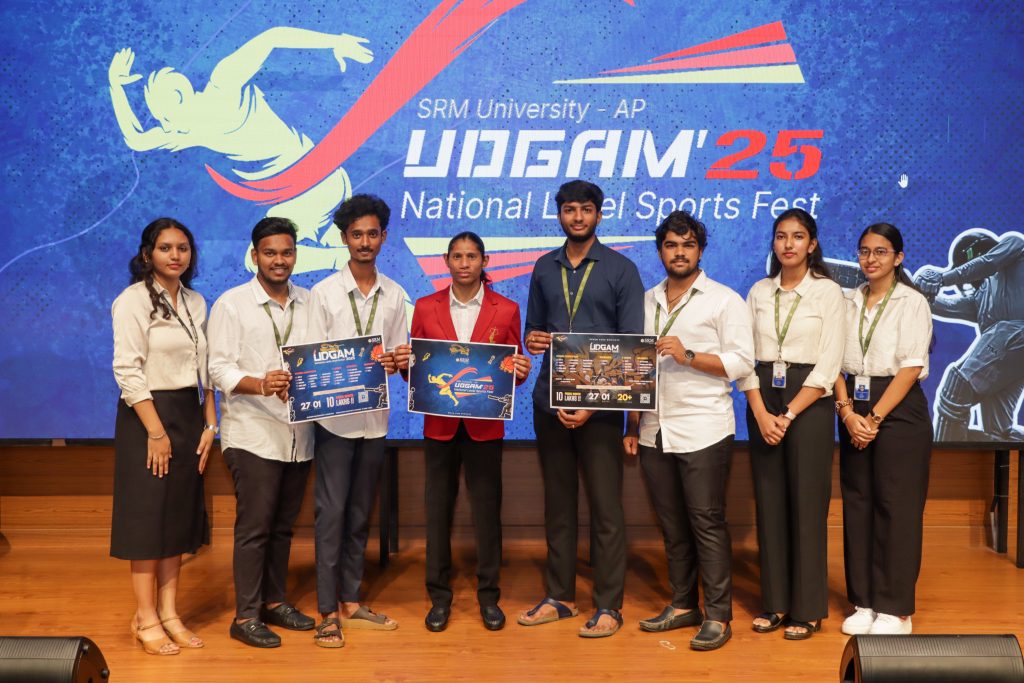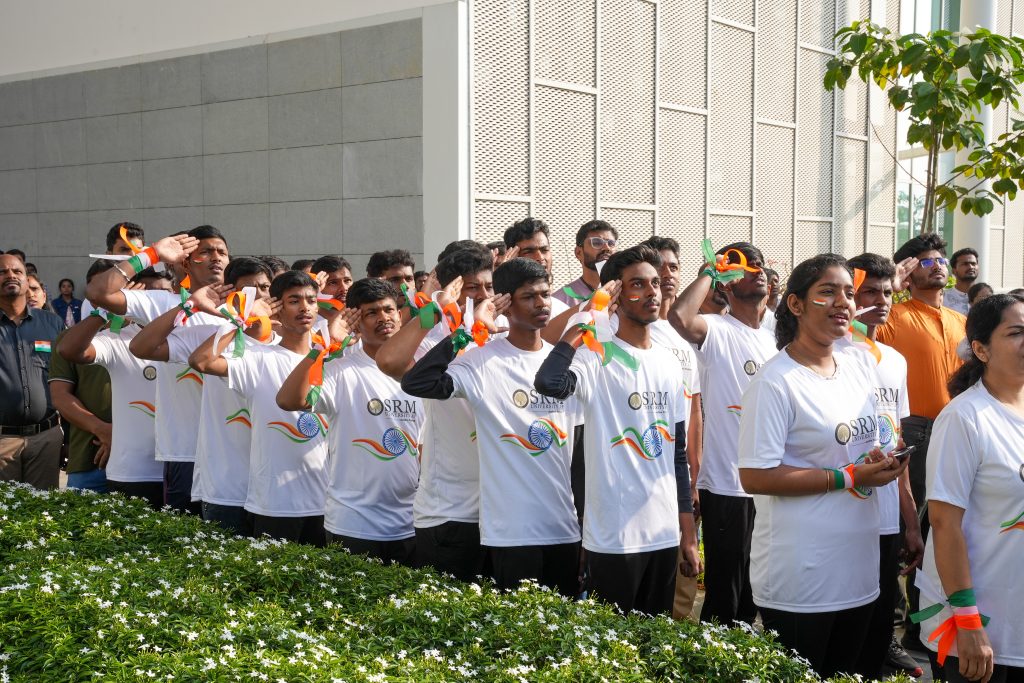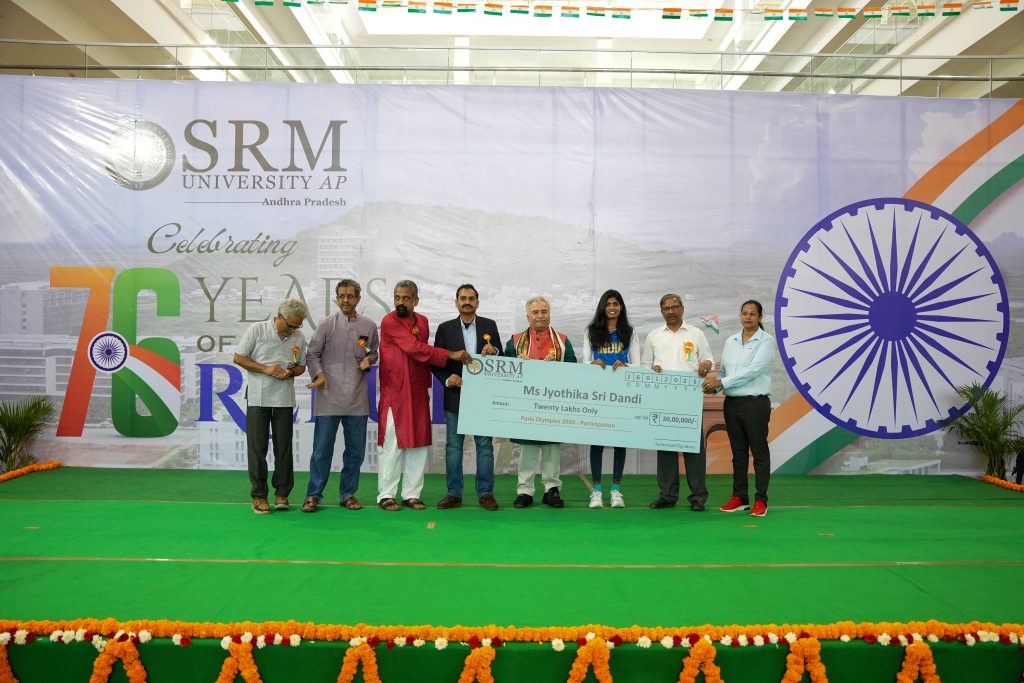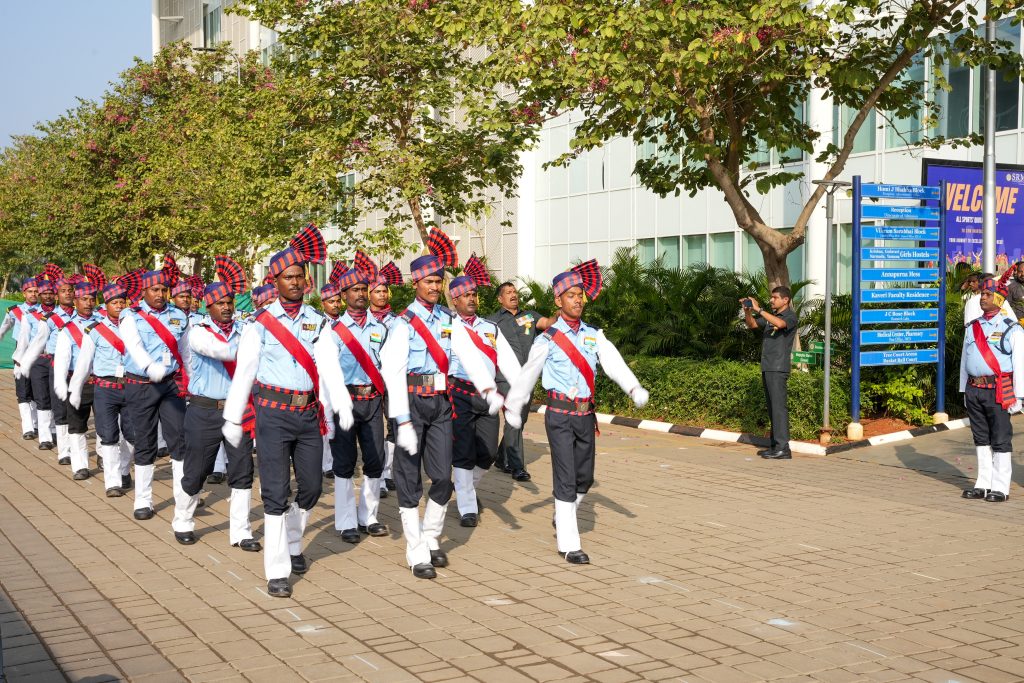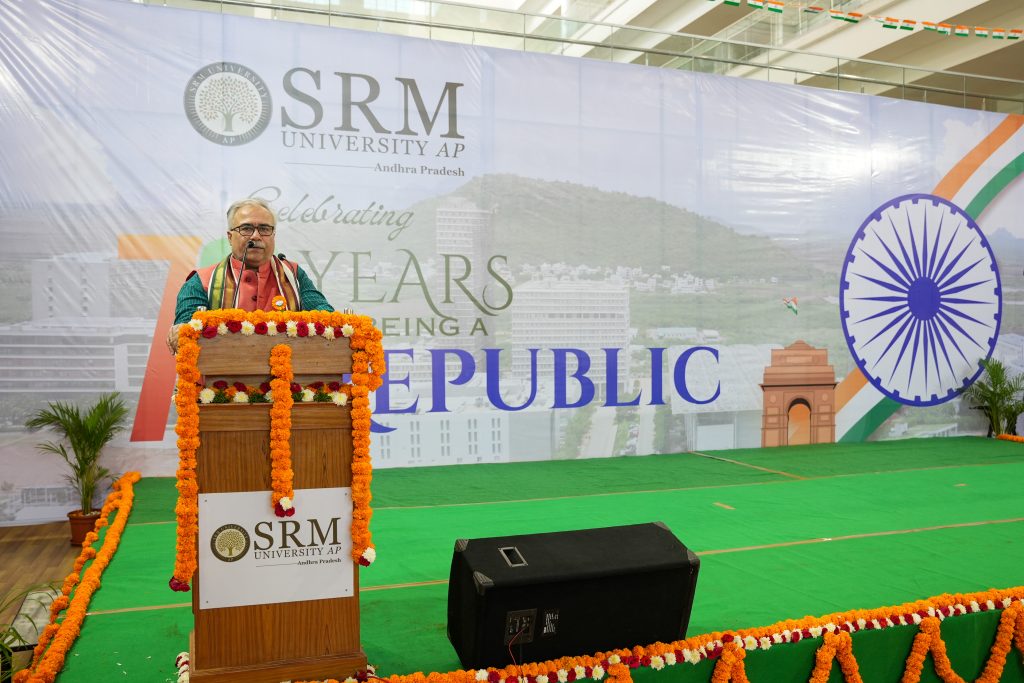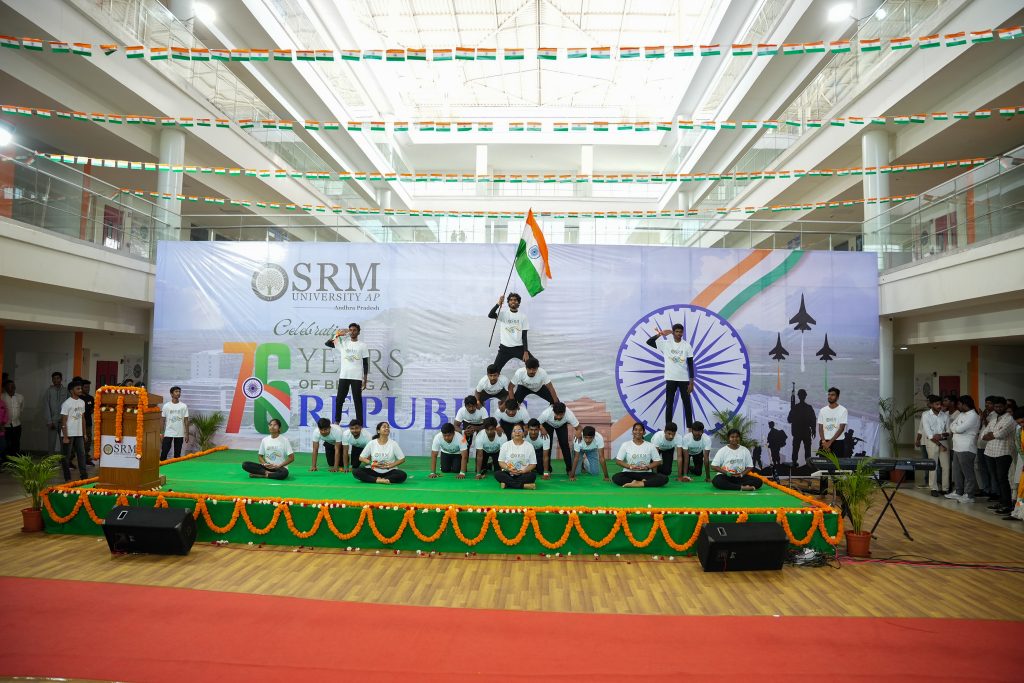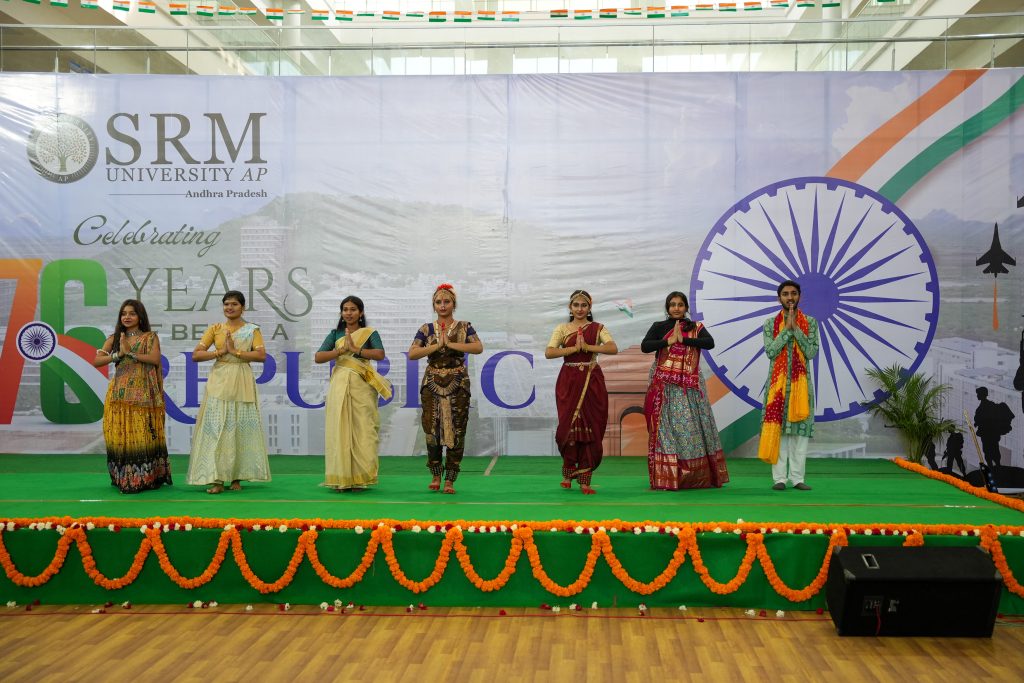Synthesising Flexible Solid-state Electrolytes for Electronic Devices
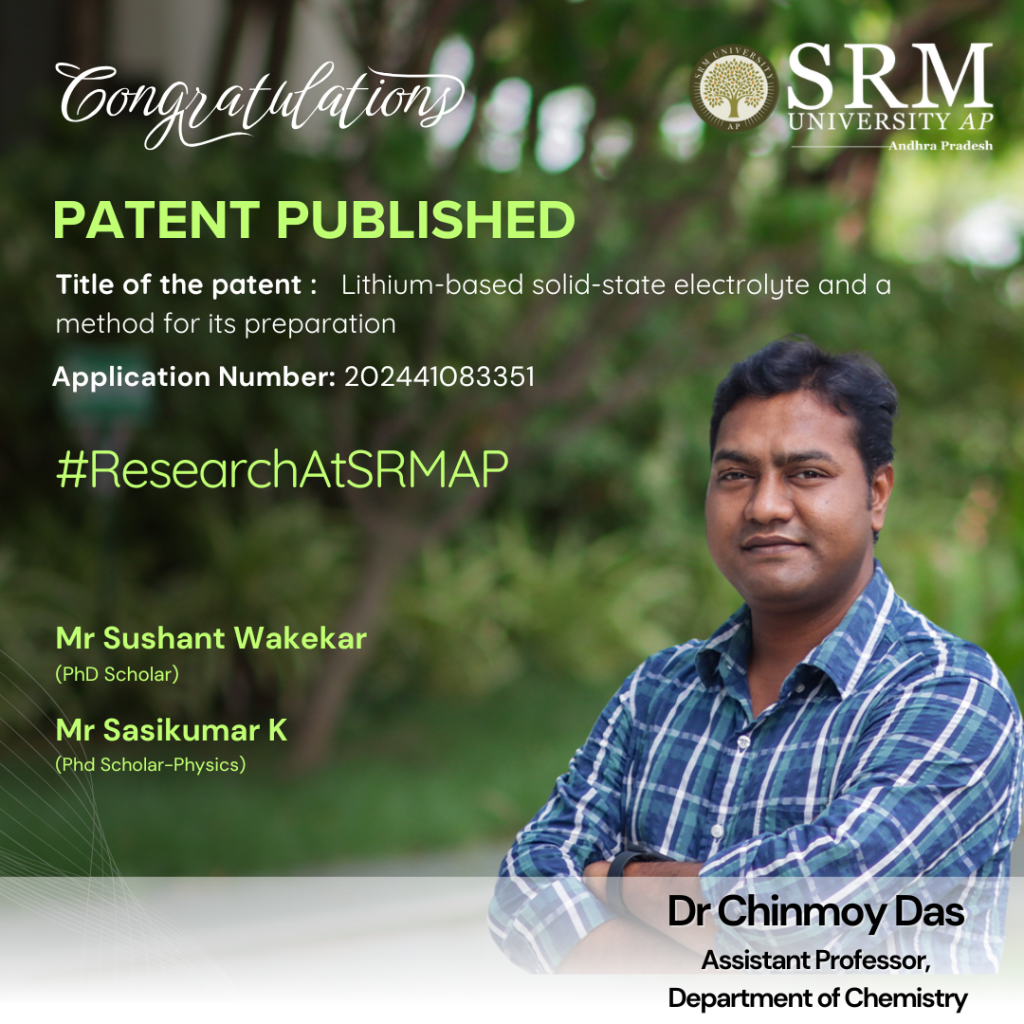
Dr Chinmoy Das, Assistant Professor from the Department of Chemistry, and scholars Mr Sushant Wakekar and Mr Sasikumar K have published their invention titled “Li-based solid-state electrolyte and a method for its preparation” in the Indian Patent Office (Patent application No. 202441083351). The invention illustrates how to synthesise inexpensive Li(I) ion-based solid-state electrolytes that are feasible for fabricating flexible electronic devices. The team worked on inexpensive and readily available starting materials that provide self-supported and flexible solid-state electrolytes to advance LIB applications.
Abstract
In our invention, we described a rapid and robust synthetic methodology to prepare novel flexible solid-state electrolytes (SSEs) suitable for the fabrication of eco-friendly lithium-ion batteries (LIBs). The mechanically flexible film has been synthesized upon in situ incorporation of Li(I) ion into two inexpensive biocompatible polysaccharide matrices through mixing. We achieved Li(I) ion-based superionic conductivity at room temperature which is feasible for the fabrication of flexible electronics in modern age society.
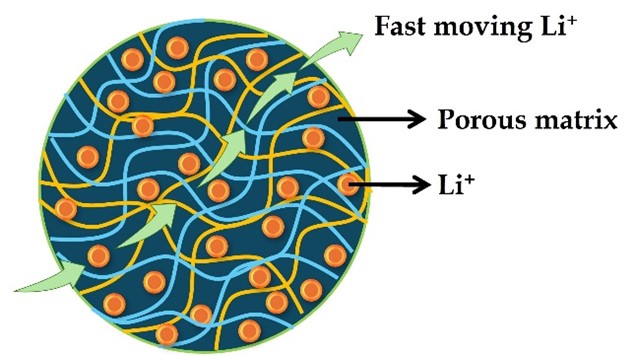
Practical Implementation/Social Implications of the Research
This invention can be implemented in various industries, such as electric vehicles (EVs), wearable and flexible electronics, and aerospace and aviation.
The team is extending their research towards the fabrication of cheaper sodium (Na+), potassium (K+)-ion based solid-state electrolytes with superionic conductivity and implementing them in designing the biodegradable sodium-ion / potassium ion batteries (NIBs / KIBs).
- Published in Chemistry-news, Departmental News, News, Research News
A Novel System for Breast Cancer Diagnosis
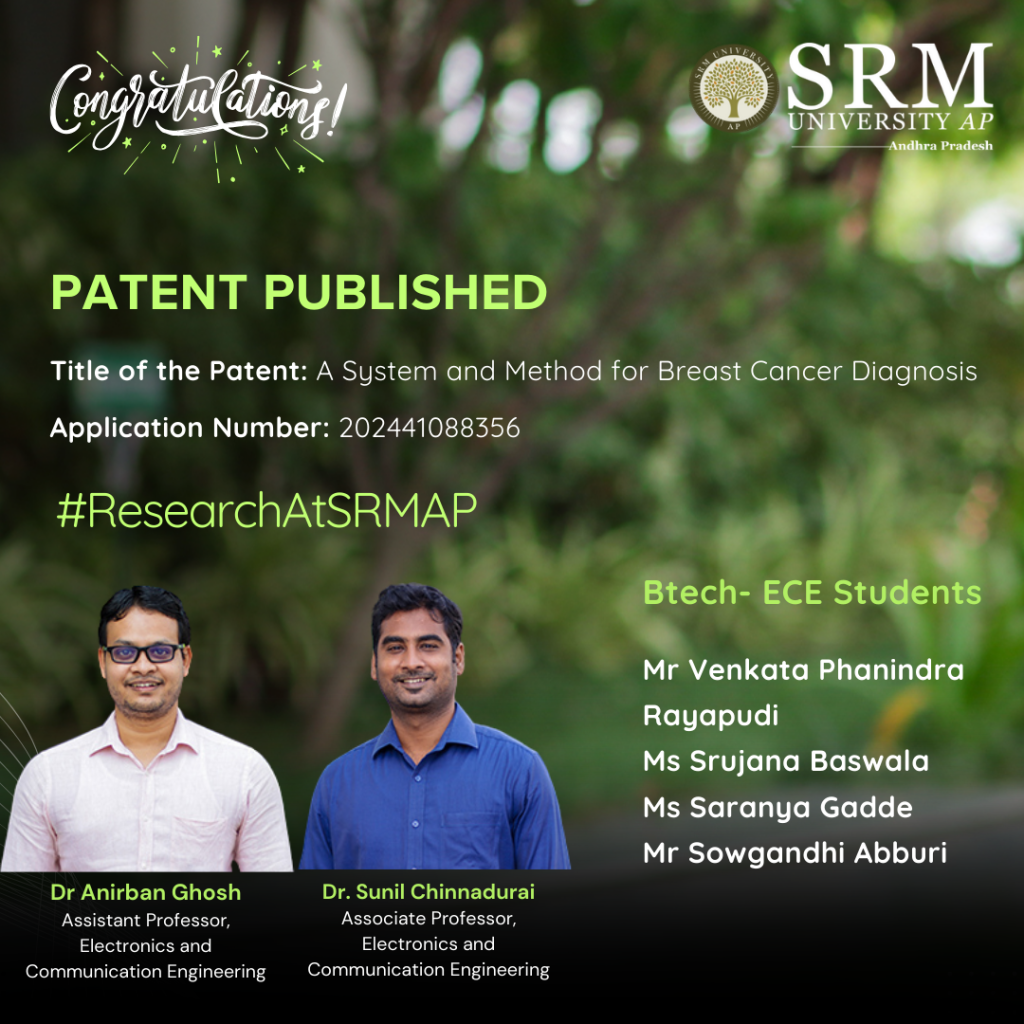
Faculty duo from the Department of Electronics and Communication Engineering, Dr Anirban Ghosh and Dr Sunil Chinnadurai, along with their research cohort, Phanindra Rayapudi Venkata, Baswala Srujana, Gadde Saranya, and Abburi Sowgandhi (B.Tech. ECE students) have published their patent titled “A System and Method for Breast Cancer Diagnosis” (Application number: 202441088356). Their cutting-edge research presents a system to help diagnose breast cancer more accurately and efficiently using advanced image analysis techniques.
Abstract
The present disclosure discloses a system for diagnosing breast cancer that utilizes topological data analysis to transform mammogram images into meaningful diagnostic insights. It includes a data preprocessing module for image standardization and enhancement and a feature extraction module to create histograms for topological analysis. The topological data analysis module converts these histograms into Persistent Homology Diagrams (PHDs) representing topological features. An Earth Mover’s Distance (EMD) matrix is generated by a similarity metric module to compare PHDs. Representative PHDs are identified using a representative selection module, enabling accurate classification by the classification module. The system’s performance is assessed through various metrics by a performance analysis module, and a web service module provides an intuitive interface for users to upload images and receive diagnostic results. This approach enhances breast cancer detection by focusing on persistent topological features, offering improved precision and interpretability.

Figure 1. Conversion of mammograms into PHDs
Explanation of the Research in Layperson’s Terms
Here’s how the system works in simple terms:
1. Preparing the Images: Mammogram images are cleaned and adjusted to ensure they’re clear and easy to analyse. The focus is on areas that might show signs of cancer.
2. Extracting Patterns: The system looks for patterns in the images that could indicate healthy or unhealthy tissue. It turns these patterns into a visual map that represents the shape and structure of the tissue.
3. Analysing Shapes: The system uses math to study how these shapes appear and disappear as the image details change. The most persistent shapes (important ones) are kept, and random noise is ignored.
4. Comparing Images: A tool measures how similar or different these patterns are between images. This helps the system group them into healthy or cancerous categories.
5. Making a Decision: The system compares a new mammogram to its library of known patterns to decide whether it’s likely healthy or shows signs of cancer.
6. Easy to Use: Doctors can upload an image to a web-based tool and quickly get results, complete with visual explanations.
This system helps doctors by making the diagnosis process faster, more reliable, and easier to understand, which can lead to earlier and better treatment for breast cancer.
Practical Implementation/Social Implications of the Research
This research enhances breast cancer detection by enabling earlier, more accurate diagnoses and improving survival rates. Its web-based tool ensures access to advanced diagnostics in remote and underserved areas, reducing disparities in healthcare. Supporting radiologists with objective insights minimizes errors and workload, especially in resource-limited settings. Patients benefit from faster, clearer results, leading to timely and cost-effective treatment. Additionally, the innovative methods could inspire advancements in diagnosing other diseases, driving broader medical progress and improving global health outcomes.
Future Research Plans
Future research could expand this system to detect other diseases like lung or liver cancer, improve diagnostic accuracy by reducing false results, and integrate multimodal data for comprehensive analysis. Incorporating patient-specific information for personalized risk assessments, creating self-learning models, and optimizing computational efficiency could enhance its adaptability. Large-scale global trials and user-friendly interfaces would ensure effective implementation across diverse populations and healthcare systems, making the technology more versatile, accessible, and impactful.
- Published in Departmental News, ECE NEWS, News, Research News
The Anxiety of Indianness in the Making of Sindhi Literature
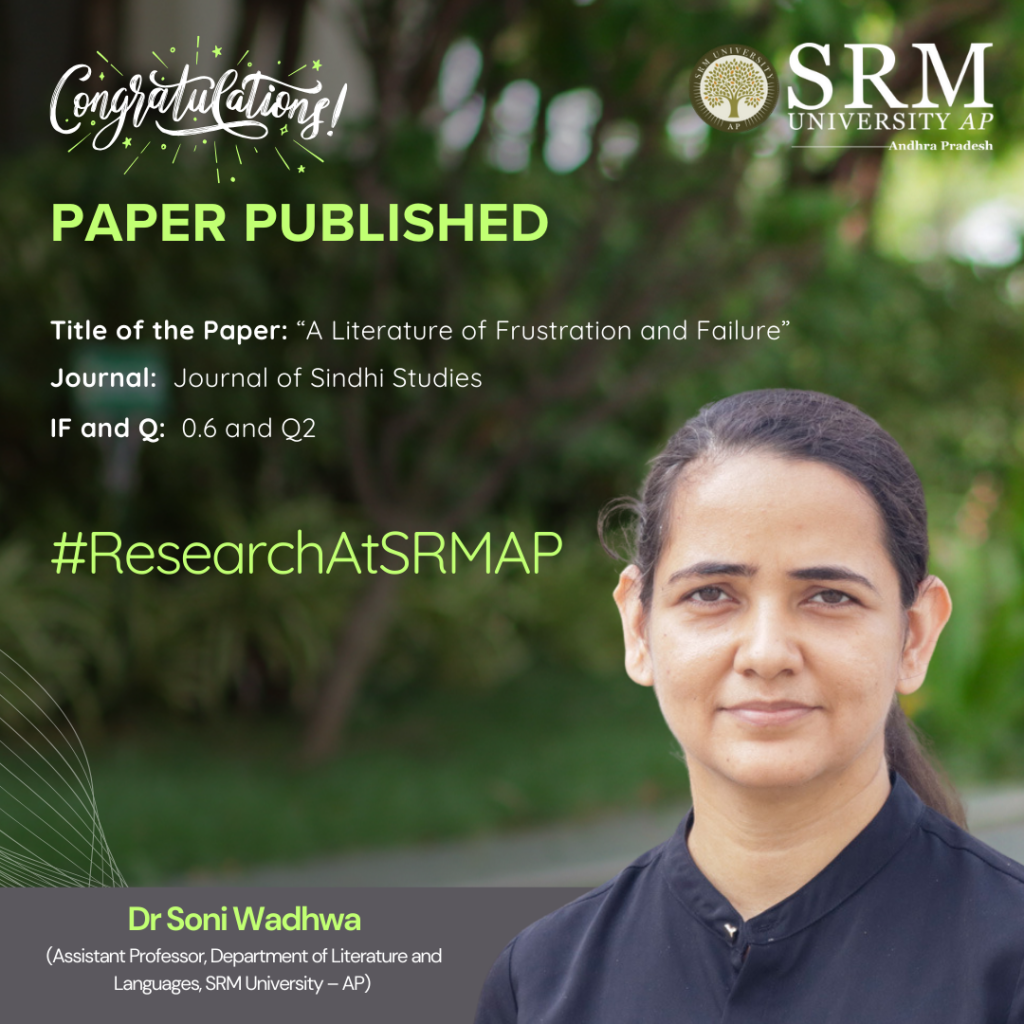
Very often, it is assumed that the “vernacular” language texts in India do not undergo any anxiety of proving themselves Indian while works written in English do. In her research paper, “A Literature of Frustration and Failure”: The Anxiety of Indianness in the Making of Sindhi Literature as an Indian Literature”, published in the esteemed Q2 journal Journal of Sindhi Studies, Dr Soni Wadhwa, Assistant Professor, Department of Literature and Languages, focuses on Sindhi post literary activity that unfolded in the first 20 years after independence to show that Sindhi has a history of going through anxiety of belonging in India.
Abstract
Studies of Partition frequently turn to literature to understand how displacement processes, among other things, impact aesthetics and representation. The article takes a broader view of aesthetics as representation: it demonstrates how turning to the literary archive of a moment and a community gives rise to questions about the politics of individual texts and literary historiography. Centred on Sindhi literature produced in India after Partition, it shows that examining the literary productivity of the community needs to involve questions of literature as political survival. It focuses on the earliest essays from the Sindhi literary scene in India (published in the Sahitya Akademi journal Indian Literature). The article argues that these essays register anxiety about the survival of a language trying to come into being in an already existing and complicated language-nation relationship. It unpacks three registers of anxiety visible in the literary archive to broaden the scope of the conversations around the Sindhi language and its literature.
This research has been conducted to advance interest in and conversations around Sindhi literature in India. Since Sindhi does not have a state in India, most people are not aware that it exists as a language and that it has a rich literary tradition.
After this article, Dr Soni Wadhwa intends to explore different writers, themes, and movements in Sindhi literature.
Collaborations
The research has been funded by George Mason University.
- Published in Departmental News, English Current Happenings, English news, News, Research News
Revolutionising Cardiac Health Monitoring with Cutting-edge Innovation
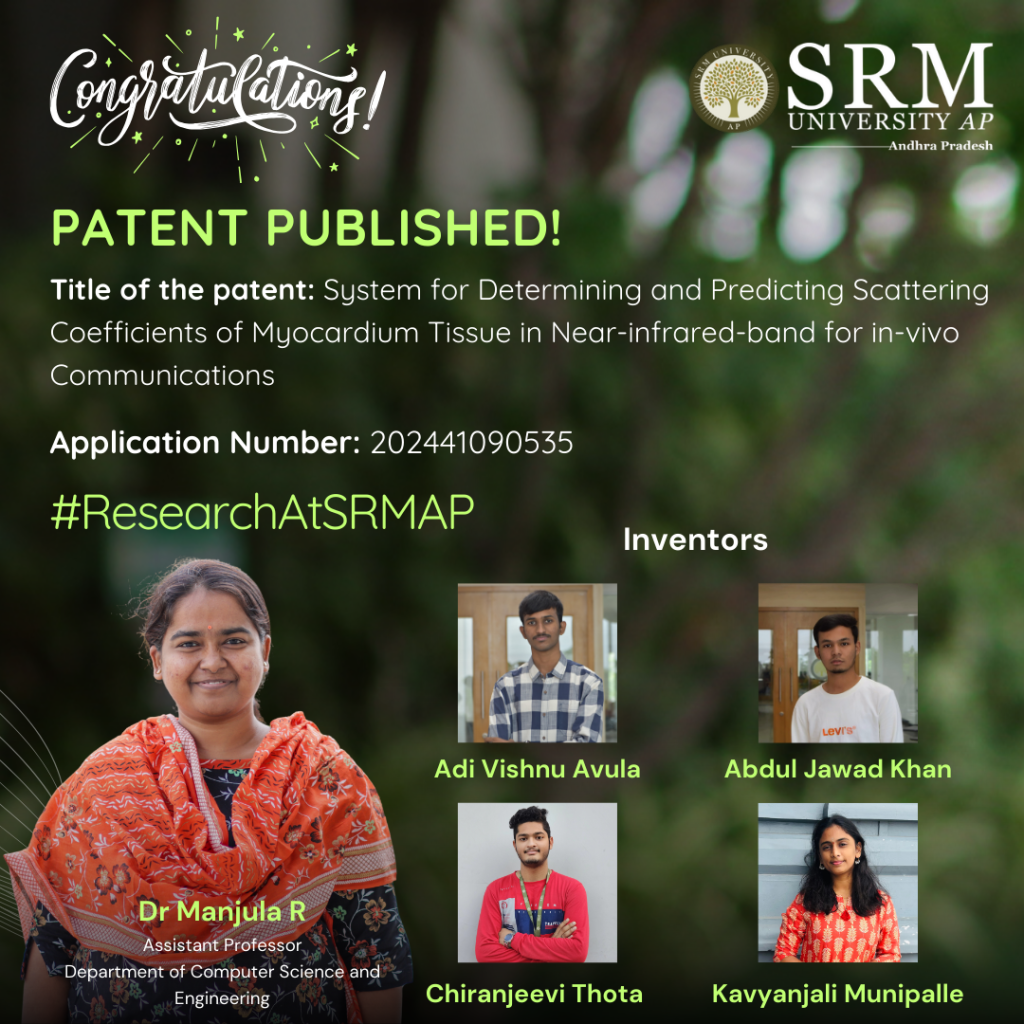
The research team consisting of Dr Manjula R, Assistant Professor from the Department of Computer Science and Engineering and her students, Mr Adi Vishnu Avula, Mr Abdul Jawad Khan, Mr Chiranjeevi Thota and Ms Kavyanjali Munipalle has published their patent titled “System For Determining And Predicting Scattering Coefficients Of Myocardium Tissue In Near-Infrared-Band For In-Vivo Communications” in the Indian Patent Office with the Application no: 202441090535.
Their research harnesses the power of machine learning and near-infrared (NIR) technology to analyse myocardium tissue with unmatched precision. By predicting scattering coefficients using advanced models like Gradient Boosting and Artificial Neural Networks (ANN), this breakthrough enables non-invasive diagnostics, early detection of heart conditions, and enhanced medical imaging. From 6G-enabled smart hospitals to regenerative medicine, this technology is set to transform healthcare.
With this groundbreaking invention, Dr Manjula and her research team pave the way for the future of connected, intelligent cardiac care!
- Published in CSE NEWS, Departmental News, News, Research News
A Critical Review in Understanding Equity and Social Justice in Mathematics Education
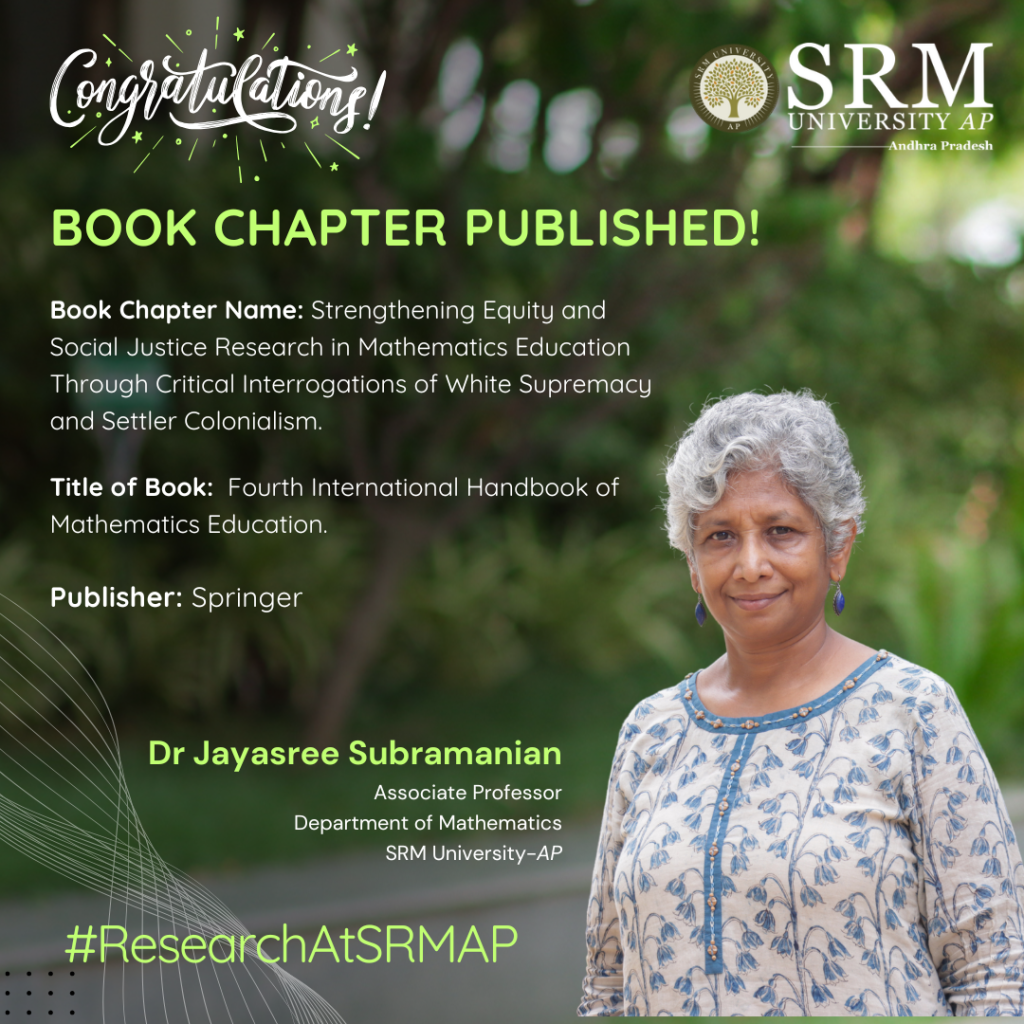
Dr Jayasree Subramanian, Associate Professor from the Department of Mathematics, has recently published a book chapter titled “Strengthening Equity and Social Justice Research in Mathematics Education Through Critical Interrogations of White Supremacy and Settler Colonialism” in the Fourth International Handbook of Mathematics Education by Springer Publications.
Abstract
In this chapter, we contextualise a suggested approach to strengthening equity and social justice research in mathematics education by inserting the mathematics education enterprise into two world events of 2020: the global COVID-19 pandemic and the global resurgence of the Black Lives Matter movement. Our intent in doing so is to underscore how white colonialism is forever present everywhere in structures and institutions around the globe, including those of the mathematics education enterprise. The logic of both white supremacy and settler colonialism are described next and then combined into a compounding scheme of colonising white supremacist logic. To illustrate that colonizing white supremacist logic is not a manifestation of only the West, a discussion of the conflicts and contradictions of white supremacy and Brahminical supremacy in the mathematics education enterprise of postcolonial India is offered. Brief summaries of the five chapters in the “Equity and Social Justice” section of this Handbook are then provided; we highlight how the chapter authors interrogated colonialising white supremacist logic within their respective chapters and point toward additional opportunities. In concluding the chapter, we feature recent USA-based mathematics education research to illustrate different possibilities when equity and social justice research is strengthened through critical interrogations of white supremacy and settler colonialism.
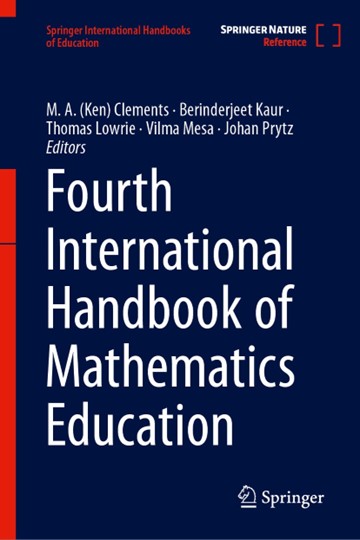
About the Book
The Fourth International Handbook discusses developments not recognised or dealt with entirely in the first three Springer Mathematics Education handbooks and tackles controversial issues in the field. After starting with a provocative introductory chapter which asks whether controversy is a healthy feature of international mathematics education, the four following sections cover: (a) mathematics education in Asia; (b) the roles of theory in research and practice; (c) equity and social justice; and (d) curriculum and change. These themes are taken up in 28 chapters by 60 authoritative authors from all continents. The four sections are structured based on past, present, and future aspects.
Like the first three mathematics education handbooks, this handbook provides a valuable resource for teachers, practitioners and researchers, education policymakers, mathematicians, and graduate and undergraduate students.
Co-authors of the Book Chapter
1. David W. Stinson, College of Education and Human Development, Georgia State University, Atlanta, GA, USA (Lead Coauthor)
2. Cathery Yeh, Center for Asian American Studies, University of Texas, Austin, TX, USA (Fellow coauthor)
- Published in Departmental News, Math News, News, Research News
Establishing an Innovative Technology for Intelligent Management of Battery Systems
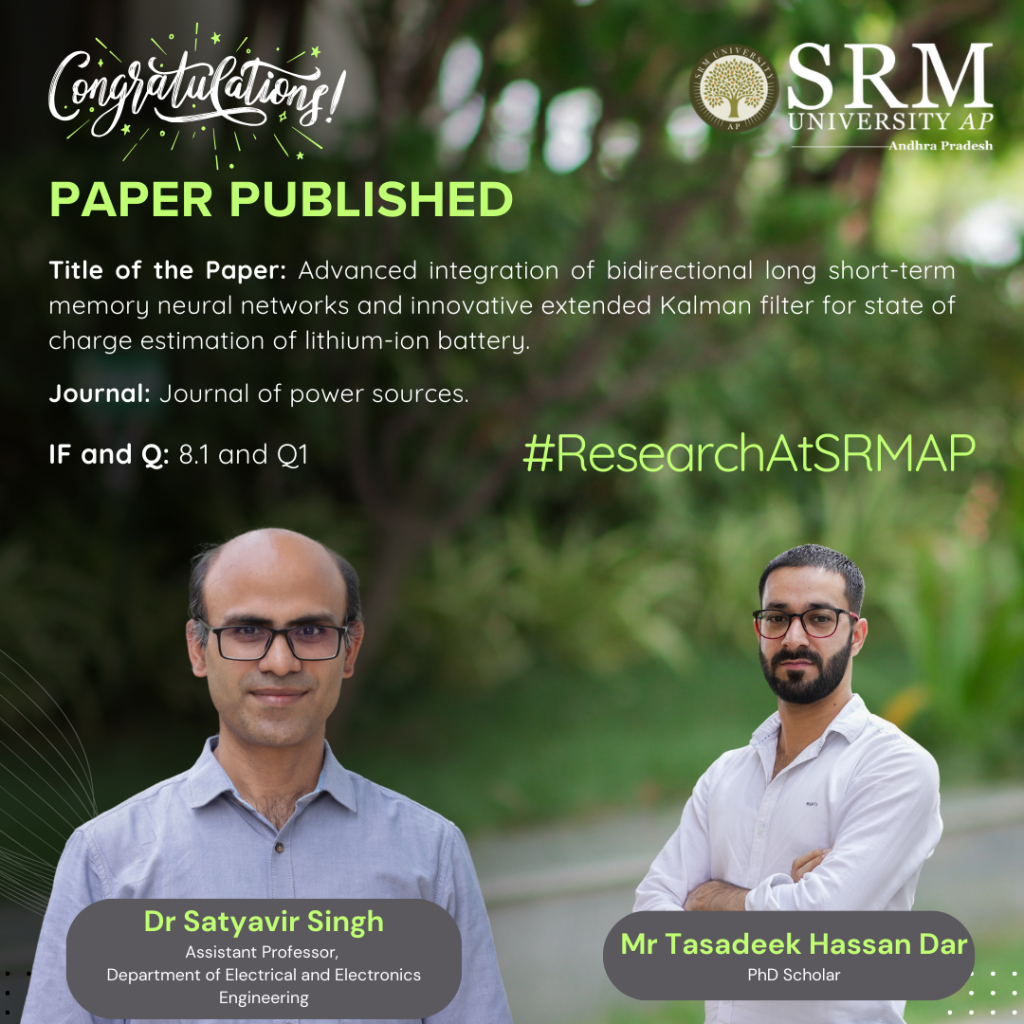
Dr Satyavir Singh, Assistant Professor from the Department of Electrical and Electronics Engineering and his PhD scholar, Mr Tasadeek Hassan Dar, have published a groundbreaking research paper titled “Advanced integration of bidirectional long short-term memory neural networks and innovative extended Kalman filter for state of charge estimation of lithium-ion battery.” The research that revolves around establishing technology for intelligent management of battery systems and their sustainability for longer life has been published in the Q1 journal, Journal of Power Sources, having an impact factor of 8.1.
Further to their research, the team will continue to work on robust techniques to BMS in the future.
Abstract
The state of charge (SoC) of a battery is a crucial monitoring indicator for battery management systems and it helps to assess how much further an electric vehicle can travel. This work proposes a novel approach for predicting battery SoC by developing a closed-loop system that integrates a bidirectional long short-term memory neural network with an innovative algorithm- extended Kalman filter. A second-order equivalent circuit model is selected, and its parameters are computed using the variational and logistic map cuckoo search approach.
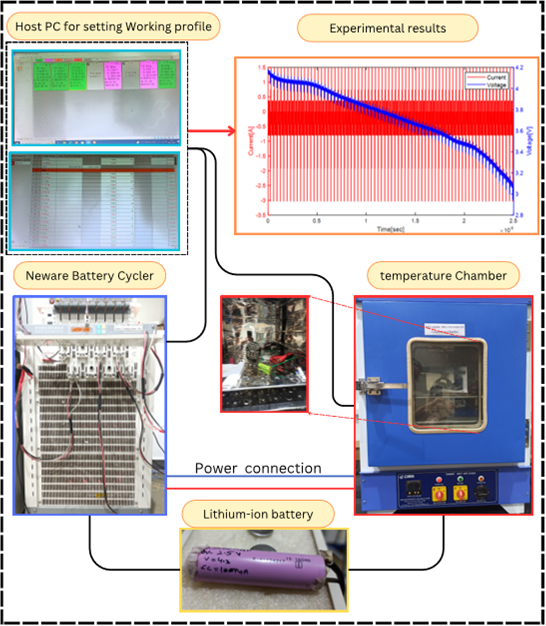
Further, an Extended Kalman filter is combined with an innovation algorithm to update process noise in real-time, and a bidirectional long short-term memory neural network takes the input from the Extended Kalman filter and gives the compensated error value for the final SoC estimation. 75% of dynamic stress test data from the Extended Kalman filter is used for training purposes, remaining data sets are used for testing purposes. The addressed algorithm is validated by evaluating its performance in comparison to individual algorithms and various combined approaches. Empirical analysis demonstrates that the proposed model achieves a root mean square error of 0.11% and mean absolute error of 0.1% positioning it as a valuable tool for battery management systems.
- Published in Departmental News, EEE NEWS, News, Research News
International Mathematicians Assemble for the RAMRA Conference at SRM AP
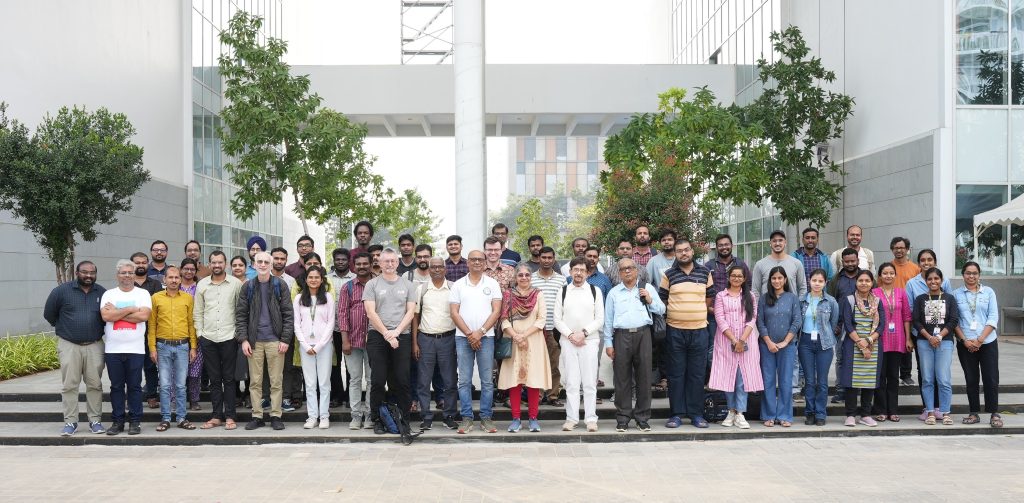
The Department of Mathematics organised the International Conference on Recent Advances in Mathematics and Related Areas 2025, from January 14 – 19, 2025, featuring the latest advancements in the field of pure and applied mathematics and theoretical computer science. The conference featured esteemed speakers like Fred Diamond (King’s College London), Ken Ribet (UC Berkeley), Jean-Marc Deshoulliers (University of Bordeaux), Gyula Katona (Alfred Renyi Institute Hungary), Olivier Ramare (CNRS France), Vita Kala (Charles University Prague) Mahan Maharaj, Anish Ghosh, Eknath Ghate (TIFR Mumbai), Apoorva Khare (IISC Bengaluru), U K Anandavardhanan (IIT Mumbai), Sukumar Adhikari (RKMVERI), B Ramakrishnan, Madhavan Mukund (CMI), Meena Mahajan (IMSc Chennai), Ken Ono (University of Virginia), and Anupam Saikia (IIT Guwahati).
The conference included sessions on topics and cutting-edge research on number theory, representation theory, Langlands program, geometry and topology, ergodic theory, lie algebra, diophantine approximation, modular forms, graph theory, combinatorial algebra, theoretical computer science, etc.
In his inaugural address, Dr Kalyan Banerjee, Assistant Professor and programme convenor from the Department of Mathematics, mentioned the importance of this conference in the research of mathematics and related areas. The Head of the Department, Prof. Kalyan Chakraborty talked about the history and relevance of this conference in the context of Indian and international mathematical communities.
On the last day of the conference, the Vice Chancellor of SRM AP, Prof. Manoj K Arora, SRM University-AP, hosted an interactive session with the distinguished speakers of the conference and other participants. In this interaction, the possibility of collaboration (both teaching and research) with different foreign universities was discussed.
The conference hosted 17 distinguished invited speakers from India and abroad and 8 young scholars. There were 40 participants from different research institutes in India, such as IISER, IMSc, CMI, and IITs. An upcoming conference proceeding will feature the articles of the invited speakers in association with Springer Proceedings. Additionally, the National Board of Higher Mathematics generously supported the conference.
- Published in Departmental News, Math News, News, Research News
Women in Leadership: Two-Day ICSSR-sponsored Conference Come to a Successful End
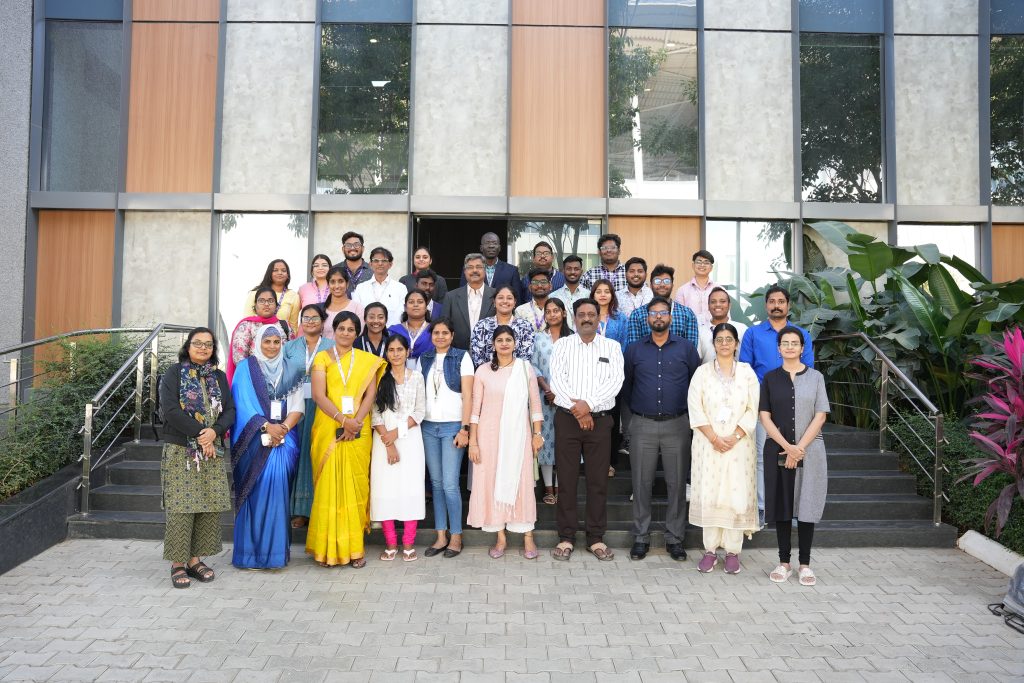
The Paari School of Business hosted its Two-Day ICSSR-sponsored National Conference on the theme “Women in Higher Educational Institutions (HEIs) and Career Progression” as part of the Vision Viksit Bharat@2047 initiative on January 23 – 24, 2025. This event brought together academics, delegates, and leaders to discuss research findings and actionable solutions for advancing gender equity in academia and leadership roles.
Prof. Bharadhwaj Sivakumaran, Dean – Paari School of Business, delivered the welcome address and officially inaugurated the conference. In his address, he highlighted the significance of the conference in promoting the Viksit Bharat Programme and fostering inclusivity in education, drawing attention to the persistent gender disparity in leadership roles within Indian academia, citing that very few Indian Institutes of Management (IIMs) have female directors and only a small percentage of Indian universities are led by women Vice-Chancellors. Prof. Bharadhwaj commended the efforts of researchers like Dr Kamesh, whose ICSSR-funded study on breaking the glass ceiling effect secured a ₹20 lakh grant, which focuses on understanding and addressing barriers that limit women’s progress to leadership positions in higher education.
The first keynote address was delivered by Ms Rekha V, Vice President of HR at vCom Solutions, California, on the glass ceiling effect, and its impact on women. She began by acknowledging the efforts of the organising committee in addressing this pressing issue and shared her perspective on the systemic barriers that hinder women’s advancement in leadership roles across sectors.
Ms Rekha commented, “There is a high underrepresentation of women in senior leadership roles, for example, in the tech sector. This disparity results from various biases that obstruct their career progression.” She emphasised that the challenges extend beyond mere representation, involving deeply ingrained issues such as unconscious bias, gender stereotypes, limited access to promotions, and inequitable pay structures, despite evidence showing that women often outperform their male counterparts.
She insisted organisations make conscious efforts to address these challenges by creating awareness about them, setting up mentorship programs, advocating for pay equity, and promoting transparent promotion practices. Her statement, “Be the change, Bring the change,” served as a reminder to actively contribute to creating diverse environments that champion gender equity and work towards shattering the glass ceiling and building societies where every woman has opportunities to rise to the highest levels. The keynote address concluded with an engaging Q&A session, during which the discussion focused on the thought-provoking questions asked by the audience.
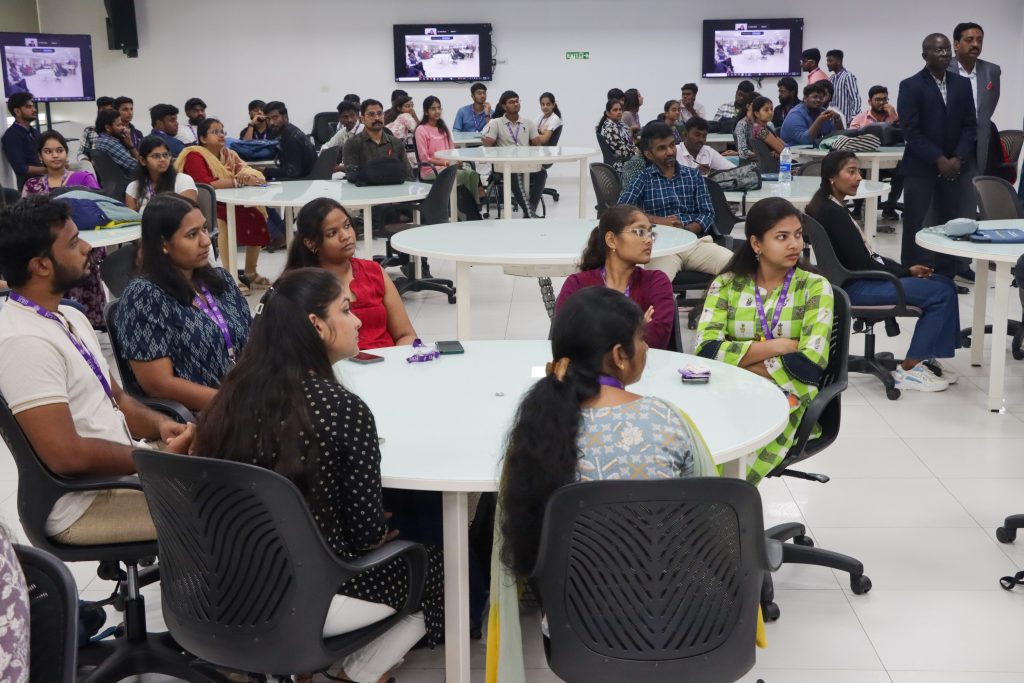
The second keynote address was delivered by Dr Syed Sadiq, a UN Women Representative from Kyrgyzstan. He commended the Paari School of Business and ICSSR for their dedication to advancing women’s rights and higher-education career opportunities. Reflecting on global progress since the first International Women’s Day in 1911, he highlighted achievements like equal voting rights, leadership opportunities, and establishing landmark treaties like the UN CEDAW (Convention on the Elimination of All Forms of Discrimination Against Women).
Despite these advancements, Dr Syed spoke about the persistent challenges women face in achieving equal pay, breaking barriers to leadership, and addressing workplace discrimination. He emphasised the need for gender-inclusive policies in higher education, targeted funding, mentorship programs, and stronger laws to combat harassment and discrimination. His “Change the Trend” and “Women Deserve More” statements were inspiring. He also discussed how systemic efforts that align with the Sustainable Development Goals (SDGs) can bring meaningful change to ensure no one is left behind.
The two-day conference also had various sessions on the barriers and biases that lead to the underrepresentation of women in leadership roles. The event concluded with a felicitation ceremony where both speakers were awarded a memento in appreciation of their remarkable sessions as keynote speakers.
- Published in Conferences, Departmental News, News, Paari Current Happenings
Student Athelete Deepthi Jeevanji Felicitated for Winning the Arjuna Award
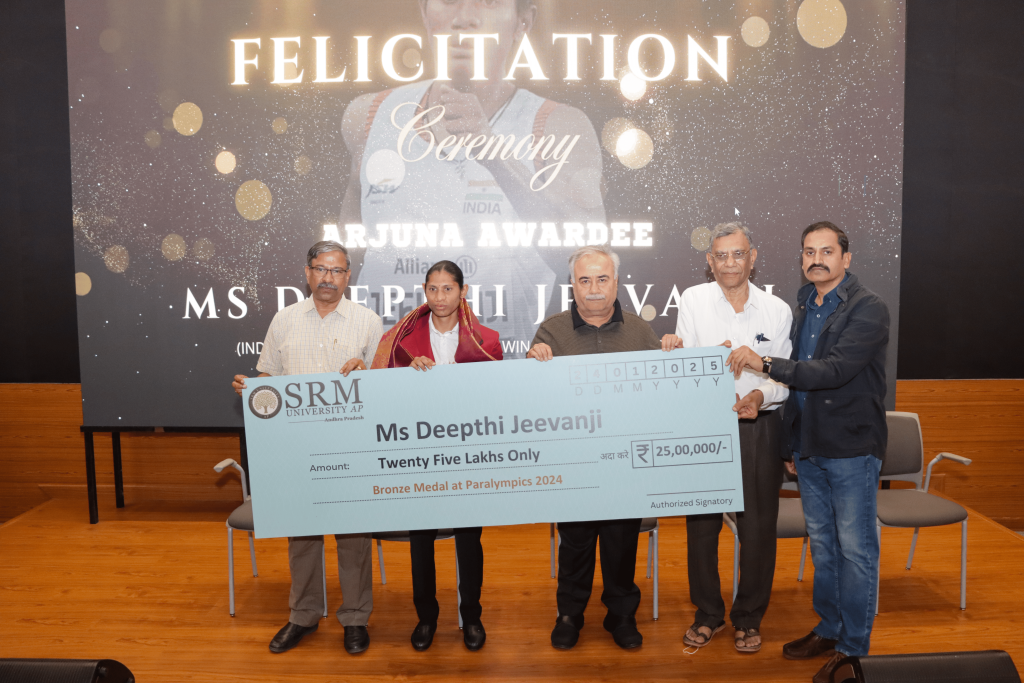
SRM University-AP honoured the accomplishments of its student and Paris Paralympian, Ms Deepthi Jeevanji, who is a recipient of the Arjuna Award this year on January 24, 2025. Deepthi, a student of commerce at the Paari School of Business, represented India at the Paris Paralympics 2024 in the 400-meter T20 event and secured a bronze medal, becoming the first intellectually impaired Indian athlete to win a Paralympic medal.
The felicitation ceremony featured Vice Chancellor Prof. Manoj K Arora, Registrar Dr R Premkumar, Director of Campus Life and Maintenance and Director I/C of Sports, Mr Anup Suryavanshi and Former IIT Madras Faculty, Prof. N Siva Prasad presented Ms Jeevanji with award cheques of rupees twenty-five lakh for her Paralympic success and an additional fifteen lakh rupees for winning the Arjuna Award.
The event served as a platform to encourage aspiring students to pursue sports and consider it as a career option. During the ceremony, Deepthi expressed her gratitude, stating, “It is an immense honour to represent my country on such a prestigious global platform. The support from the management, staff, and my teachers at SRM University-AP played a crucial role in helping me achieve success.”
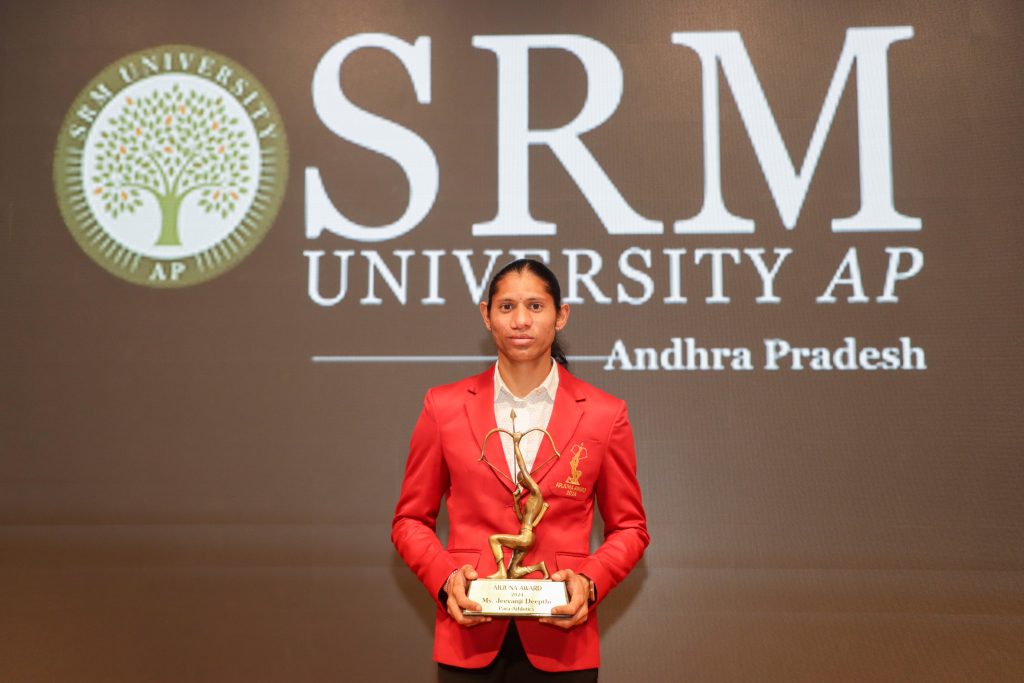
Vice Chancellor Prof. Manoj K Arora highlighted the importance of sports in education and the university’s commitment to fostering a culture of excellence. He stated, “We are proud of her achievement and hope she participates in the next Paralympics too, bringing gold to the country.” He also emphasised that the university is here to provide any form of support for her way forward in sports. Registrar Dr R Premkumar acknowledged Deepthi’s remarkable accomplishment and expressed pride in her historic success.
Director – Campus Life and Maintenance and Director I/C of Sports, Mr Anup Singh Suryavanshi, mentioned in the press meeting that followed, SRM University-AP has allocated seventy lakh rupees to encourage its high-performing students in sports. He noted that the university’s sporting infrastructure is on par with international standards and welcomes students from across the country to join its Sports Department.
The felicitation event also saw the announcements of the university’s upcoming National-Level Sports Fest, UDGAM 2025 which will see participation from over 3,200 students from across the country. Arjuna Awardee Ms Deepthi Jeevanji unveiled the event brochure to the members of the media.
- Published in News, Sports News, Students Achievements
76th Republic Day Celebrations: Student-Athlete and Olympian Jyotika Sri Dandi Rewarded with Cash Prize
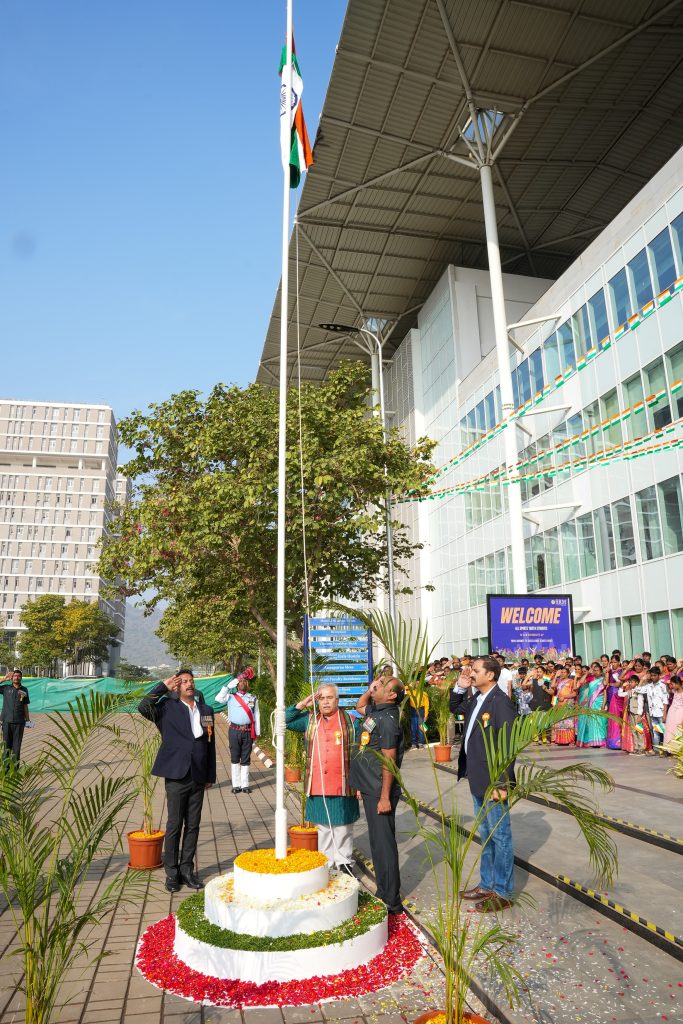
SRM University-AP honoured the 76th Year of India as a Republic with regal celebrations at the campus. Vice Chancellor Prof. Manoj K Arora hoisted the flag in the presence of Registrar Dr R Premkumar, Deans and Directors, faculty, staff and students, followed by a parade by the security staff of the university. Ms Jyotika Sri Dandi, student of Easwari School of Liberal Arts who represented the Indian team at the Women’s 4x400m Relay for the Paris Olympics 2024, was also present for the occasion.
In his address, Prof. Manoj K Arora spoke about the country’s golden heritage and the battle for freedom led by our freedom fighters and visionary leaders, which led to the momentous victory of Purna Swaraj. He underscored the significance of our Constitution representing the values that unite the diverse nation. “Our country has developed in leaps and bounds with our pivotal position on the global economic front, achievements in education and sports, and our advanced space programme. India is on its way to becoming a developed nation by 2047, and we must strive together as citizens to achieve this inclusive vision,” stated Prof. Arora in his address. He also briefed on the university’s stellar growth in academics, research and innovation, entrepreneurial startups, infrastructure and the plan for the upcoming year.
The celebration also witnessed the felicitation of the student-athlete and Olympian, Ms Jyotika Sri Dandi, who participated in the Paris Olympics 2024. The university awarded her a reward cheque of Rs 20 Lakhs for her remarkable contribution to Indian sports and her alma mater. In her address of gratitude, she stated, “SRM University-AP provided me with immense support for my academics with scholarships and the best resources for training. With two Olympians already in its fold, I am sure that in 10 years we will harbour the best contingent of athletes and academicians among all Indian universities.”
Pro-Chancellor Dr P Sathyanarayanan sanctioned Rs 70 lakh to be awarded to students who have won various national and inter-university sports championships. Cash prizes ranging from Rs 15,000 to Rs 1,00,000 were awarded to student-athletes for their exemplary sports performances during the event. Faculty and staff who have rendered five years of service to the university were also honoured with a memento and certificate in recognition of their contribution to the university’s development. The Republic Day celebrations concluded with various cultural programmes by students celebrating the diversity of the great nation.
- Published in Events, News, University Event


